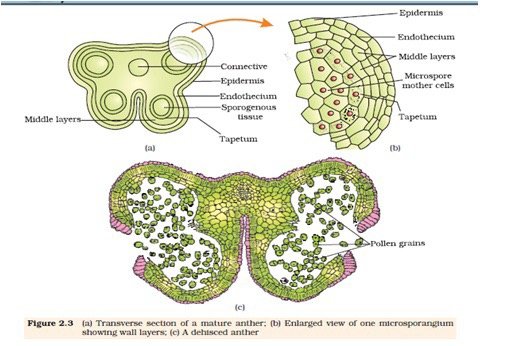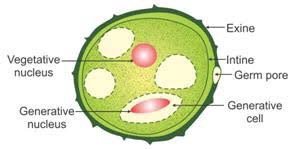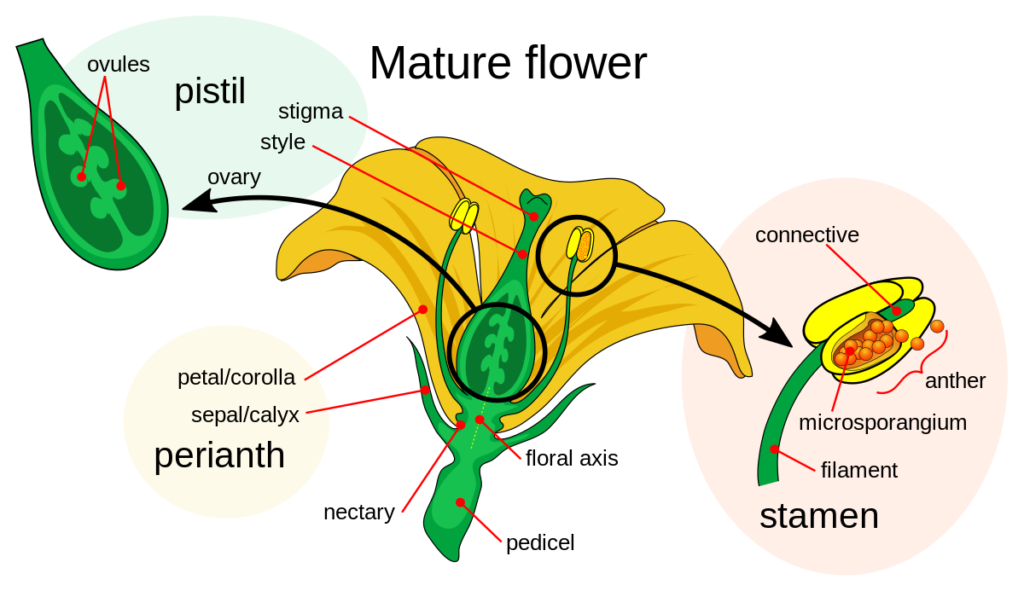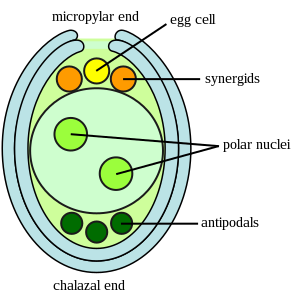SEXUAL REPRODUCTION IN FLOWERING PLANTS
INTRODUCTION
- All flowering plants show sexual reproduction.
- Flowers are objects of aesthetic, ornamental, social, religious and cultural value. They have always been used as symbols for conveying important human feelings such as love, affection, happiness, grief, mourning etc.
- Much before the actual flower is seen on a plant, the decision that the plant is going to flower has taken place. Several hormonal and structural changes differentiate and develop the floral primordium, which form inflorescences, bear floral buds and then the flowers.
PRE-FERTILISATION-STRUCTURES AND EVENTS
Stamen, Microsporangium and pollen Grain
- Androecium, consists of a whorl of stamens, representing the male reproductive organ.
A typical Stamen has two parts
|____________________________|
1. FILAMENT 2. ANTHER
FILAMENT
- It is long slender stalk.
- The proximal end of the filament is attached to the thalamus or the petal of the flower.
The number and length of stamens are variable in flowers of different species.
ANTHER
>The terminal generally bilobed structure is anther.
> Each lobe having two theca i.e. dithecous.
> Often a longitudinal groove runs lengthwise separating the theca.
> The anther is a four-sided (tetragonal) structure consisting of four microsporangia located at the corners, two in each lobe.
> The microsporangia develop further and become pollen sacs. They extend longitudinally all through the length of anther and are packed with pollen grains.
STRUCTURE OF MICROSPORANGIUM
- In a T.S., a typical microsporangium appears near circular. It is generally surrounded by four wall layers.
FOUR ANTHER WALL LAYERS
- Epidermis, Endothecium and Middle layers – The outer 3 wall layers perform the function of protection and help in dehiscence of anther to release the pollen.
- Tapetum – Inner most wall layer. Nourishes the developing pollen grains. Cells of tapetum possess dense cytoplasm and have more than one nucleus.
- Sporogenous tissue – Compactly arranged homogenous cells: occupies the centre of each microsporangium.

MICROSPOROGENESIS
- Microsporogenesis is a process of formation of microspores from PMC (Pollen Mother Cell)
- As the anther develops→ Cells of the sporogenous tissue (PMC)→ Undergoes MEIOSIS→ to form microspore tetrad.
- Each cell of the sporogenous tissue is a potential pollen or microspores mother cell.
- The microspores, as they are formed, are arranged in a cluster of four cells- the microspore tetrad.
- As the anthers mature and dehydrate, the microspores dissociate from each other and develop into pollen grains.
Note:- Sporopollenin is one of most resistant organic material known. It can withstand high temperature, strong acids and alkali. No enzyme that can degrade it is known. Pollen grains are well preserved as fossil due to it.
POLLEN GRAIN
- Pollen grains represent the male gametophytes. A variety of architecture-sizes, shapes, colours designs are seen on pollen grains from different species.
- It has prominent two layered wall-exine and intine.
> Generative cell:-
- Small, floats in the cytoplasm of vegetative cell; spindle shaped with dense cytoplasm and a nucleus.
> Vegetative cell- Bigger,has abundant food reserve and a large irregularly shaped nucleus.
> Exine- outer hard layer made of sporopollenin.
Has germ pores where sporopollenin is absent.
> Intine:- Inner wall layer, thin continou, made of cellulose and pectin
Note:- pollen grains are generally spherical, measuring 25-50 micrometers in diameter.

POLLEN VIABILITY
- In over 60% of angiosperms, pollen grains are shed at 2-celled stage, in the remaining species, generative cell divides mitotically to give rise to two male gametes before pollen grains are shed (3-celled stage)
- Pollen grains of many species cause severe allergies , chronic respiratory disorders, asthma, brochties etc. e.g. Parthenium (carrot grass) came to India as acotaminant with wheat, became ubiquitous in occurrence and causes pollen allergy.
- Pollen grains are in nutrients. Pollen tablets and syrups has been claimed to increase performance of athletes and race horses.
- Pollen viability- Highly variable. Depends to some extent on prevailing temperature and humidity.
- In some creales like rice and wheat pollen grains lose viability within 30 minutes of release.
- In some members of Rosaceae, Leguminoseae and Solanaceae, viability can be for months.
- It is possible to store pollen of a large number of species for years in liquid nitrogen(-196°C) in pollen banks for crop breeding programmes.
PISTIL, MEGASPORANGIUM (OVULE)
AND EMBRYO SAC
- Gynoecium represents female reproductive part. Gynoecium may consist of single pistil (monocarpellary) or may have more than one pistil (multicarpellary). It may be free, (apocarpous) e.g. Michella or fused (syncarpous), e.g. papaver.
- Each pistil has three parts:-
1. Stigma:- Landing platform for pollen grains.
2. Style:- Elongated slender part below stigma
3. Ovary:- Basal bulged part of pistil, has ovarian cavity (locule). Placenta is located inside ovarian cavity. Megasporangia called ovules arise from placenta. - One ovule in ovary- e.g. wheat, paddy and mangy
- Many ovule in ovary- e.g. papaya, watermelon, orchids.

- In embryo sac 3 called egg apparatus, at micropylar end (1 egg cell and two synergids with filiform apparatus, which guide pollen tube into the synergid). 3 antipodals at chalazal end a large central cell, with two polar nuclei remain present.
- Embryo sac formationfrom single megaspore is termed minosporic development.

MEGASPORANGIUM (OVULE)
- Hilum- Region where body fuses with funicle.
- Funicle- Stalk of ovule
- Micropyle- opening, where integument rmain absent
- . Micropyle pole
- Outer integument –
- Inner integument- Protective envelops.
- Nucellus- Mas of cells
- Embryo sac- Located in the nucellus
Chalaza- Represents basal part of the ovule
MEGASPOROGENESIS
- Process of formation of megaspores from megaspores mother cells.
- Ovules generally differentiate a single megaspore mother cell (MMC) in micropylar region of nucellus.
- MMC→Meiosis→ 4 megaspores.
(2n) (n)
Female Gametophyte/Embryo sac
- In majority of flowering plants one megaspores remains functional and 3 degenerate.
- The functional megaspore develops thefemale gametophyte (embryo sac).
- The nucleus of functional megaspore undergoes free-nuclear mitotic divisions result 8-nucleate stage, after that cell walls are laid down to form the typical 7-celled-8 nucleate female gametophyte or embryo sac.
POLLINATION
Transfer of pollen shed from anther to sigma of a pistil pollination can be divided into three types
(1) AUTOGAMY
- Pollination is achieved within same flower. e..g. transfer of pollen from anther to the stigma of same flower.
- It requires sychrony in pollen release and stigma receptivity.
- Cleistogamous flowers (Which do not open) are invariably autogamous, eg. Viola (common pansy), Oxalis and Commelina and provide assured seed set even in absence of pollinators.
- These species also produce chasmogamous flowers (with exposed anther and stigma) for cross- pollination.
(2) GEITONOGAMY
- Transfer of pollen grains from anther to stigma of another flower of the same plant
- It is functionally cross pollination involving pollinating agents, genetically it is similar to autogamy, since the pollen grains come from the same plant.
(3) XENOGAMY
- Transfers of pollen grains from anther to the stigma of a different plant.
- This is the only type of pollination which brings genetically different types of pollen grains on the stigma.
AGENTS OF POLLINATION
- ABIOTIC AGENTS
- Pollen coming in contact with stigma is achance factor in both wind and water pollination. So flowers produce enormous amount of pollen when compared to number of ovules available for pollination. It is to compensate loss of pollen grains.
WIND POLLINATION:- - Requires light, non-sticky pollen so that they can be transported by wind currents. Well exposed stamens and large often- feathery stigma to trap air borne pollen, single ovule in each ovary and numerous flowers in an inflorescence. Tassels in corn to trap pollen
- Quite common in grasses.
- Pollination by wind is more common among abiotic pollinations.
WATER POLLINATION:-
- Pollination by water is quite rare, limited to 30 genera, of monocotyledons e.g. Vallisneria, Hydrilla, Zostera (sea grass).
- In majority of aquatic plants like water hyacinth and waterlily, flowersemerge above water and are pollinated by insects or wind.
- In vallisneria pollination takes place on the surface of water (epihydrophily), in sea grasses it takes place below water (hypohydrophily).
- In most water-pollinatied species, pollen grains are protected from wetting by a mucilaginous covering.
2. BIOTIC AGENTS - Majority of flowering plants use a range of animals as pollinating agents-Bees, butterflies, flies, beetles wasps, ants, moths, birds (sunbirds and humming birds) and bats.
- Among animals, insects particularly bees are dominant pollinating agents.
- Some primates (lemurs) arboreal (tree dwelling) rodents or even reptiles (gecko lizard and garden lizard) are also pollinators in some species.
- Insect-pollinating flowers are large, colourful, fragrant and rich in nectar. Small flowers are dustered in inflorescence to make them conspicuous.
- Animals are attacted to flowers by colour and/or fragrance.
- Flowers pollinated by flies and beetles secrete foul odours to attract these animals.
- Nectar and pollen grains are usual floral rewards.
- In some species floral rewards are in providing safe places to lay eggs, eg. Amorphophallus,. A species of moth and Yucca- cannot complete their life cycles without each other.
OUTBREEDING DEVICES
- Flowering plants have developed many devices to discourage self, pollination and to encourage cross pollination, For example-
- Pollen release and stigma receptivity are not synchronised.
- Anther and stigma are placed at different positions so that pollen connot come in contact with stigma of the same flower.
- Self-incompatibility is agenetic mechanism which prevents self pollen which prevents self pollen from fertilizing the ovules by inhibiting pollen germination or pollen tube growth in the pistil.
- Production of unisexual flowers.
- In castor and maize (monoecious) autogamy is prevented but not geitonogamy. In papaya (dioecy), both autogamu and geitonogamy are prevented.
POLLEN-PISTIL INTERACTION
- The ability of pistil to recognise the pollen followed by its acceptance or rejection is the result of a continuous dialogue between pollen grain and the pistil. Its a dynamic process.
- This dialogue is mediated by chemical components of the pollen interacting with those of the pistil.
- Following compatible pollination, pollen tube grows through the tissues of the stigma and style, the contents of pollen grain move into pollen tube.
- The growing pollen tube carrying two non-motile male gamets, reaches the ovary, enters the ovule through micropyle and then enters one of the synergids through the filiform apparatus, which guides the entry of pollen tube.
- All these events- from pollen deposition on the stigam until pollen tubes enter the ovule- are together referred to as pollen-pistil interaction.
ARTIFICIAL HYBRIDISATION
- In such crossing, desired pollen are used for pollination and stigma is protected from contamination from unwanted pollen by emasculation and bagging
- If female parent bears bisexual flowers emasculation is followed by bagging and rebagging after dusting mature pollen, for fruit development.
- If female flowers are unisexual there is no need of emasculation.
Note:- - Knowledge gained in pollen-pistil interactions can help plant breeders even in compatible pollination to get desired hybrids.
- Continued self-pollination result in inbreeding depressions.
DOUBLE FERTILISATION
- Pollen tube releases the two male gametes into the cytoplasm of the synergid.
- One of the males gametes fuses with egg to form the diploid zygote (SYNGAMY). The other male gamete moves towards the polar nuclei of the central cell and fuses with them to produce triploid primary endosperm nucleus (PEN). It is TRIPLE FUSION.
- Syngamy and triple fusion are called double fertilisation, an event unique to flowering plants.
The central cell after triple fusion becomes primary endosperm cell (PEC) and develop into endosperm..
APOMIXIS AND POLYEMBRYONY
- Some species of Asteraceae and grasses have evolved a special mechanism to produce seeds without fertilisation called apomixis. A form of asexual reproduction that mimics sexual reproduction.
- In some species diploid egg cell formed without reduction division develops into embryo without fertilisation.
- In Citrus and mango nucellar cells protrude into embryo sac and develops into embryos, so each ovule contains many embryos-polyembryony.
- Hybrid seeds have to be produced every year as the progeny plants will segregate and will not be able to maintain hybrid characters. But if hybrid seeds are made into apomicts, there is no segregation of characters in hybrid progeny. So active research is going on to understand the genetics of apomixis and transfer apomictic genes into hybrid varieties.
POST-FERTILISATION: STRUCTURE AND EVENTS
(A) ENDOSPERM
- Endosperm development precedes embryo development.
- The cells of triploid endosperm are filled with reserve food materials and used by developing embryo.
- The most common type of endosperm, is nuclear type (PEN undergoes successive nuclear divisions to give free nuclei) eg. coconut water, and sorrounding white kernel is cellular endosperm.
(B) EMBRYO - Embryo develops at micropylar end of embryo sac where the zygote is situated.
- Most zygotes divide only after certain amount of endosperm is formed. This adaption provides assured nutrition to the developing embryo.
- Early stages of embryo development (EMBRYOGENY)are similar in both monocotyledons and dicotyledons.
- In dicots the zygote forms→ Proembryo→globular→heart-shaped → mature embryo.
- A typical dicot embryo has embryonal axis and two cotyledons. Epicotyl terminates with plumute or stem tip; hypocotyl terminates at its lower tip in radical or root tip covered by root cap.
- Embryos pf monocot has only one cotyledon. In grass family it is called scutellum towards lateral side of the embryonal axis. Radicle or root cap enclosed with undifferentiated sheath called coleorhiza. Epicotyl has shoot apex and a few leaf primordia enclosed in foliar structure coleoptile.
(C) SEED - In angiosperms,seed (fertilised ovule) is the final product of sexual reproduction, formed inside fruits. A seed typically consists of seed coats, cotyledon(s) and an embryo axis
- Matuer seeds may be non-albuminous or ex-albuminous, having no residual endosperm, which is consumed completely during embryo development (eg. pea, groundnut). Albuminous seeds retain a part of endosperm (eg. Wheat, maize, barley castor, coconut)
- In black pepper and beet, remnants of nucellus are also persistent, called perisperm
- Wall of ovary develops into pericarp. True fruits develop from ovary.
- In apple, strawberry, cashew, etc, thalamus also contributes to form fruit called false fruit
- Parthenocarpic fruit develop without fertilisation eg. Banana.
- Seeds form the basis of agriculture.
- Lupinus arcticus seed germinated and flowered after estimated record 10,000 years of dormancy. Phoenix dactylifera (date palm) seed remained viable for 2000 years.